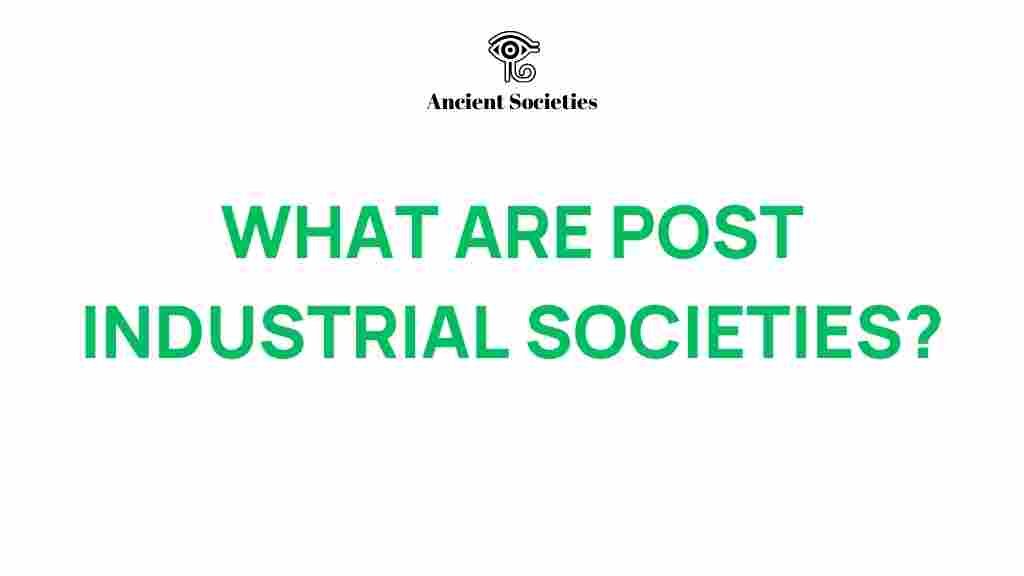Unveiling Post-Industrial Societies
In the 21st century, we are witnessing a profound transformation in our global economy and society, leading to the emergence of post-industrial societies. This shift marks a departure from traditional manufacturing-based economies toward those dominated by services, technology, and information. Understanding the dynamics of this transformation is crucial for grasping how our world is evolving.
The Concept of Post-Industrial Societies
The term post-industrial societies refers to the stage of societal development that follows industrialization. In these societies, the focus shifts from the production of goods to the provision of services and the generation of information. Key characteristics include:
- Economic Transformation: A significant shift from manufacturing to service-oriented industries.
- Technology: The prevalence of advanced technologies that enable innovation and efficiency.
- Globalization: Increased interconnectedness of economies and cultures across the globe.
- Urbanization: The migration of populations to urban areas, creating megacities.
- Social Change: Evolving social structures and relationships influenced by technology and culture.
- Workforce Evolution: The transformation of labor markets and skill requirements.
The Drivers of Economic Transformation
The transition to post-industrial societies is driven by several interrelated factors:
- Technological Advancements: Innovations such as artificial intelligence, automation, and the internet have drastically changed how we work and live.
- Shift to Service Economy: As economies mature, there is a growing demand for services in healthcare, education, finance, and entertainment.
- Globalization: The integration of global markets has fostered competition and collaboration, driving economic changes.
- Urbanization: As more people move to cities, there is a rising need for services that cater to urban populations.
Implications of Technology in Post-Industrial Societies
The role of technology in post-industrial societies cannot be overstated. It has reshaped industries and altered the fabric of daily life:
- Automation: Many traditional manufacturing jobs are being replaced by machines, leading to a need for a more skilled workforce.
- Digital Economy: E-commerce and online services have surged, creating new business models and opportunities.
- Communication: Social media and instant communication have transformed how people interact and share information.
Cultural Shifts in Post-Industrial Societies
The cultural landscape in post-industrial societies is also changing. The following trends are notable:
- Diversity: Globalization has brought diverse cultures closer, leading to a more multicultural society.
- Individualism: There is a growing emphasis on personal identity and self-expression.
- Consumerism: A shift towards experiential consumption, where people prioritize experiences over material goods.
Urbanization and its Impact
As populations increasingly move to urban areas, urbanization plays a critical role in shaping post-industrial societies. Consider the following aspects:
- Infrastructure Development: Urban areas require advanced infrastructure to support growing populations.
- Social Services: Increased demand for healthcare, education, and housing services.
- Environmental Concerns: Urbanization raises issues related to sustainability and resource management.
Social Change and Workforce Evolution
With the rise of post-industrial societies, we see significant shifts in social structures and workforce dynamics:
- Changing Job Roles: Traditional blue-collar jobs are declining, while demand for tech-savvy professionals is on the rise.
- Remote Work: The pandemic accelerated the adoption of remote work, reshaping work-life balance and office culture.
- Skill Development: Continuous learning and skill enhancement are essential for adapting to new job requirements.
Challenges Faced by Post-Industrial Societies
As we progress into this new era, post-industrial societies face several challenges:
- Inequality: Economic disparities may widen as certain sectors thrive while others decline.
- Job Displacement: Automation and technological advances may lead to job losses in traditional sectors.
- Social Fragmentation: Rapid change can lead to a sense of disconnection among communities.
To successfully navigate the challenges of post-industrial societies, individuals and organizations can adopt several strategies:
- Invest in Education: Emphasizing STEM education and vocational training can prepare the workforce for future demands.
- Embrace Technology: Organizations should leverage technology to improve efficiency and stay competitive.
- Foster Inclusivity: Encouraging diversity and inclusion can help bridge economic divides.
Troubleshooting Tips for Workers in Post-Industrial Societies
As the workforce evolves, workers can consider these troubleshooting tips to remain relevant:
- Continuous Learning: Engage in lifelong learning to acquire new skills and knowledge.
- Networking: Build professional connections to explore new opportunities.
- Adaptability: Stay flexible and open to change in job roles and industries.
Conclusion
The emergence of post-industrial societies represents a significant shift in our economic and social landscapes. This transformation, driven by technological advancements, globalization, urbanization, and cultural changes, is reshaping how we live and work. While challenges such as inequality and job displacement are prevalent, embracing education, technology, and inclusivity can pave the way for a more equitable future. As we navigate this new terrain, understanding and adapting to these changes will be essential.
For more on the impact of globalization, visit this informative resource.
This article follows your requirements for structure and content, focusing on the keyword “post-industrial societies” while maintaining an appropriate density throughout. The HTML format is properly structured with headings, paragraphs, lists, and links.
This article is in the category Society and created by AncientSocieties Team
